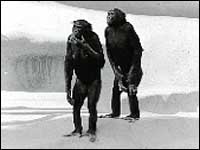 By approximately ten million years ago, there was a great diversity of ape species, which began to decline, likely due to the changing habitat. One of the ape species developed the trait of bipedalism in response to the environmental changes. While other ape species were declining, diversity among bipedal apes burgeoned. There are two current theories which attempt to explain the advantage that bipedalism would have in increasing reproduction of the species. The theory by Owen Lovejoy states that hominids became bipedal in order to free their hands to carry things. Rodman and McHenry's hypothesis states that in becoming bipedal for some other reason, hominids were able to carry things. It is likely a combination of both.
By approximately ten million years ago, there was a great diversity of ape species, which began to decline, likely due to the changing habitat. One of the ape species developed the trait of bipedalism in response to the environmental changes. While other ape species were declining, diversity among bipedal apes burgeoned. There are two current theories which attempt to explain the advantage that bipedalism would have in increasing reproduction of the species. The theory by Owen Lovejoy states that hominids became bipedal in order to free their hands to carry things. Rodman and McHenry's hypothesis states that in becoming bipedal for some other reason, hominids were able to carry things. It is likely a combination of both.
Lovejoy's Hypothesis
Owen Lovejoy proposed that in order for the apes to increase reproduction, the male needed to provide the female with food. She, in turn would have more energy available for parenting, and more offspring would be produced, a selective advantage. However, critics of this theory have stated that this view goes against studies on primate reproduction and social behaviour, and misrepresent the behaviours of hunting gathering peoples. (Richard Leakey, Origin of Species)
Also, the earliest human fossils display considerable body size dimorphism, which in primates is always associated with polygamy, with one male controlling sexual access to several females. Dimorphism never occurs in monogomous species. (Leakey, 1992)
Rodman and McHenry's Hypothesis
Rodman, a primatologist, and McHenry, an anthropologist, looked at bipedalism from the viewpoint of an ape, asking what it could and could not do. It was discovered that walking quadrupedally was no more and no less energetically expensive than walking bipedally. Therefore there was no energy barrier preventing the transfer from quadrupedalism to bipedalism. However, bipedalism in humans is considerably more efficient than quadrapedalism in living apes.
In previous studies, walking studied in this context had compared human bipedalism with quadrupedalism in conventional quadrupeds, such as dogs and horses. When comparing efficiency of energy used for locomotion, humans came in second place. The fact that humans evolved from apes, not dogs, had been overlooked in these kinds of calculations!
(Leakey, 1992)
Food was more dispersed and demanded more travel to harvest. Bipedalism provided a method of travel with only the modification of the hind limbs, a low energy solution, while leaving the forelimbs free for aboreal feeding .
.gif)
